Spring 2019-2020: B205B TMA on Entrepreneurship and Innovation
VerifiedAdded on 2022/07/28
|8
|2518
|30
Essay
AI Summary
This essay delves into the concepts of entrepreneurship and innovation, investigating the impact of new technologies on entrepreneurial activities. It examines the dimensions of entrepreneurship and innovation, with a focus on how digital technologies, including the Internet of Things and artificial intelligence, are reshaping business operations. The essay also analyzes organizational culture, using Google as a case study to explore how its culture influences its innovation capabilities and competitiveness. The discussion includes cultural dimensions such as power distance, uncertainty avoidance, individualism, and masculinity, as well as the role of innovation leadership. The conclusion emphasizes the importance of digital technologies and organizational culture in fostering innovation and achieving a competitive edge. The essay is a TMA assignment for the Arab Open University's B205B course.
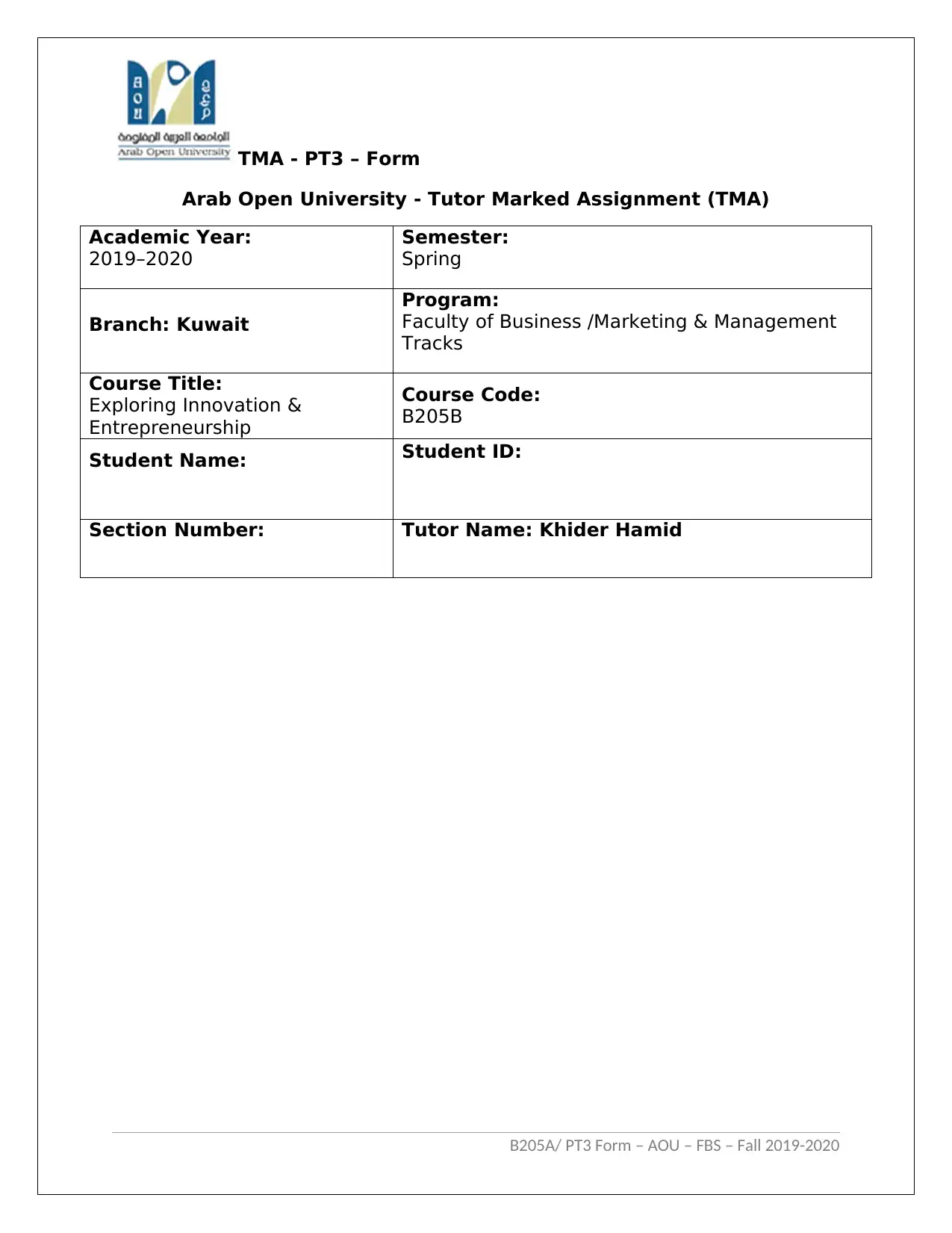
TMA - PT3 – Form
Arab Open University - Tutor Marked Assignment (TMA)
Academic Year:
2019–2020
Semester:
Spring
Branch: Kuwait
Program:
Faculty of Business /Marketing & Management
Tracks
Course Title:
Exploring Innovation &
Entrepreneurship
Course Code:
B205B
Student Name: Student ID:
Section Number: Tutor Name: Khider Hamid
B205A/ PT3 Form – AOU – FBS – Fall 2019-2020
Arab Open University - Tutor Marked Assignment (TMA)
Academic Year:
2019–2020
Semester:
Spring
Branch: Kuwait
Program:
Faculty of Business /Marketing & Management
Tracks
Course Title:
Exploring Innovation &
Entrepreneurship
Course Code:
B205B
Student Name: Student ID:
Section Number: Tutor Name: Khider Hamid
B205A/ PT3 Form – AOU – FBS – Fall 2019-2020
Paraphrase This Document
Need a fresh take? Get an instant paraphrase of this document with our AI Paraphraser
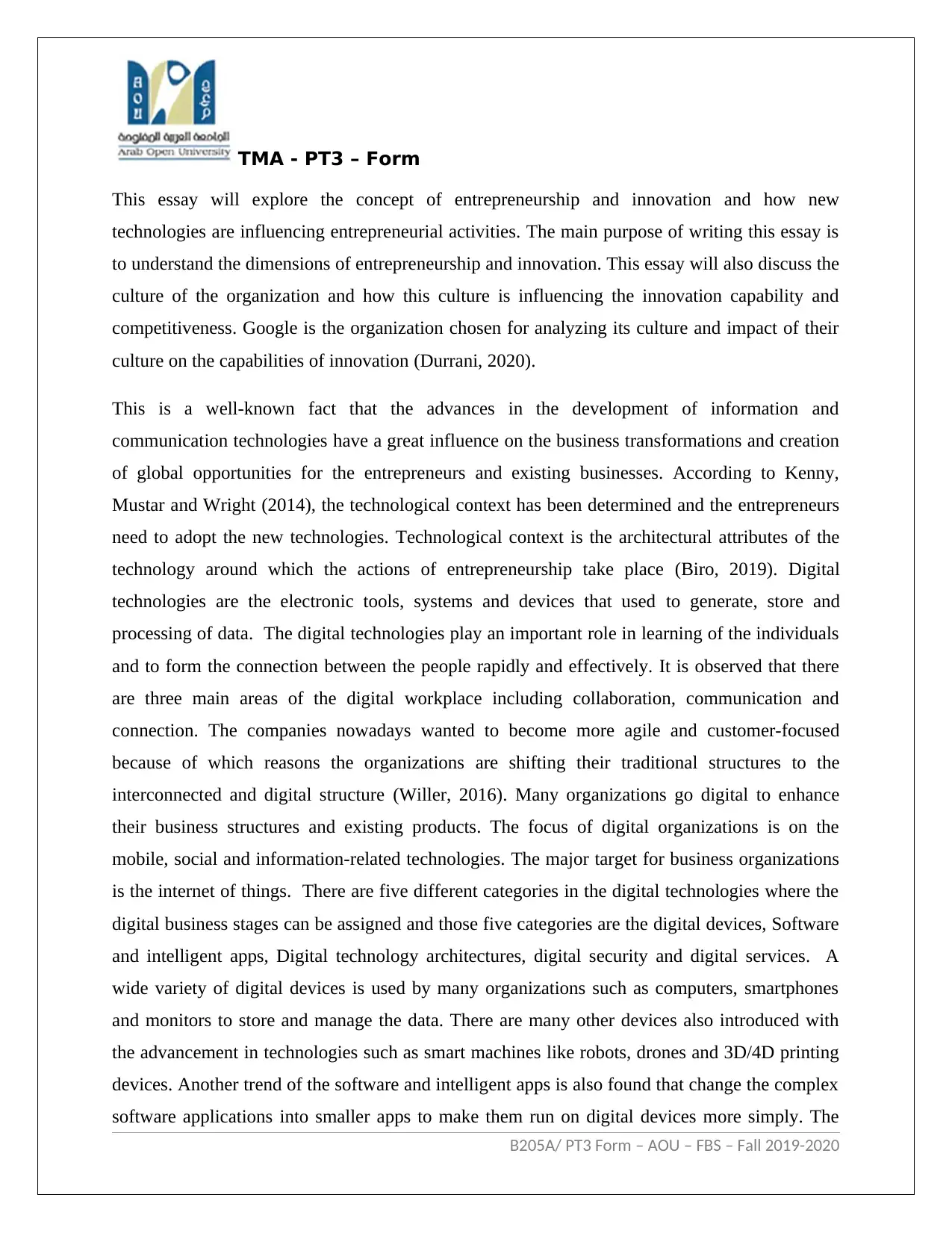
TMA - PT3 – Form
This essay will explore the concept of entrepreneurship and innovation and how new
technologies are influencing entrepreneurial activities. The main purpose of writing this essay is
to understand the dimensions of entrepreneurship and innovation. This essay will also discuss the
culture of the organization and how this culture is influencing the innovation capability and
competitiveness. Google is the organization chosen for analyzing its culture and impact of their
culture on the capabilities of innovation (Durrani, 2020).
This is a well-known fact that the advances in the development of information and
communication technologies have a great influence on the business transformations and creation
of global opportunities for the entrepreneurs and existing businesses. According to Kenny,
Mustar and Wright (2014), the technological context has been determined and the entrepreneurs
need to adopt the new technologies. Technological context is the architectural attributes of the
technology around which the actions of entrepreneurship take place (Biro, 2019). Digital
technologies are the electronic tools, systems and devices that used to generate, store and
processing of data. The digital technologies play an important role in learning of the individuals
and to form the connection between the people rapidly and effectively. It is observed that there
are three main areas of the digital workplace including collaboration, communication and
connection. The companies nowadays wanted to become more agile and customer-focused
because of which reasons the organizations are shifting their traditional structures to the
interconnected and digital structure (Willer, 2016). Many organizations go digital to enhance
their business structures and existing products. The focus of digital organizations is on the
mobile, social and information-related technologies. The major target for business organizations
is the internet of things. There are five different categories in the digital technologies where the
digital business stages can be assigned and those five categories are the digital devices, Software
and intelligent apps, Digital technology architectures, digital security and digital services. A
wide variety of digital devices is used by many organizations such as computers, smartphones
and monitors to store and manage the data. There are many other devices also introduced with
the advancement in technologies such as smart machines like robots, drones and 3D/4D printing
devices. Another trend of the software and intelligent apps is also found that change the complex
software applications into smaller apps to make them run on digital devices more simply. The
B205A/ PT3 Form – AOU – FBS – Fall 2019-2020
This essay will explore the concept of entrepreneurship and innovation and how new
technologies are influencing entrepreneurial activities. The main purpose of writing this essay is
to understand the dimensions of entrepreneurship and innovation. This essay will also discuss the
culture of the organization and how this culture is influencing the innovation capability and
competitiveness. Google is the organization chosen for analyzing its culture and impact of their
culture on the capabilities of innovation (Durrani, 2020).
This is a well-known fact that the advances in the development of information and
communication technologies have a great influence on the business transformations and creation
of global opportunities for the entrepreneurs and existing businesses. According to Kenny,
Mustar and Wright (2014), the technological context has been determined and the entrepreneurs
need to adopt the new technologies. Technological context is the architectural attributes of the
technology around which the actions of entrepreneurship take place (Biro, 2019). Digital
technologies are the electronic tools, systems and devices that used to generate, store and
processing of data. The digital technologies play an important role in learning of the individuals
and to form the connection between the people rapidly and effectively. It is observed that there
are three main areas of the digital workplace including collaboration, communication and
connection. The companies nowadays wanted to become more agile and customer-focused
because of which reasons the organizations are shifting their traditional structures to the
interconnected and digital structure (Willer, 2016). Many organizations go digital to enhance
their business structures and existing products. The focus of digital organizations is on the
mobile, social and information-related technologies. The major target for business organizations
is the internet of things. There are five different categories in the digital technologies where the
digital business stages can be assigned and those five categories are the digital devices, Software
and intelligent apps, Digital technology architectures, digital security and digital services. A
wide variety of digital devices is used by many organizations such as computers, smartphones
and monitors to store and manage the data. There are many other devices also introduced with
the advancement in technologies such as smart machines like robots, drones and 3D/4D printing
devices. Another trend of the software and intelligent apps is also found that change the complex
software applications into smaller apps to make them run on digital devices more simply. The
B205A/ PT3 Form – AOU – FBS – Fall 2019-2020
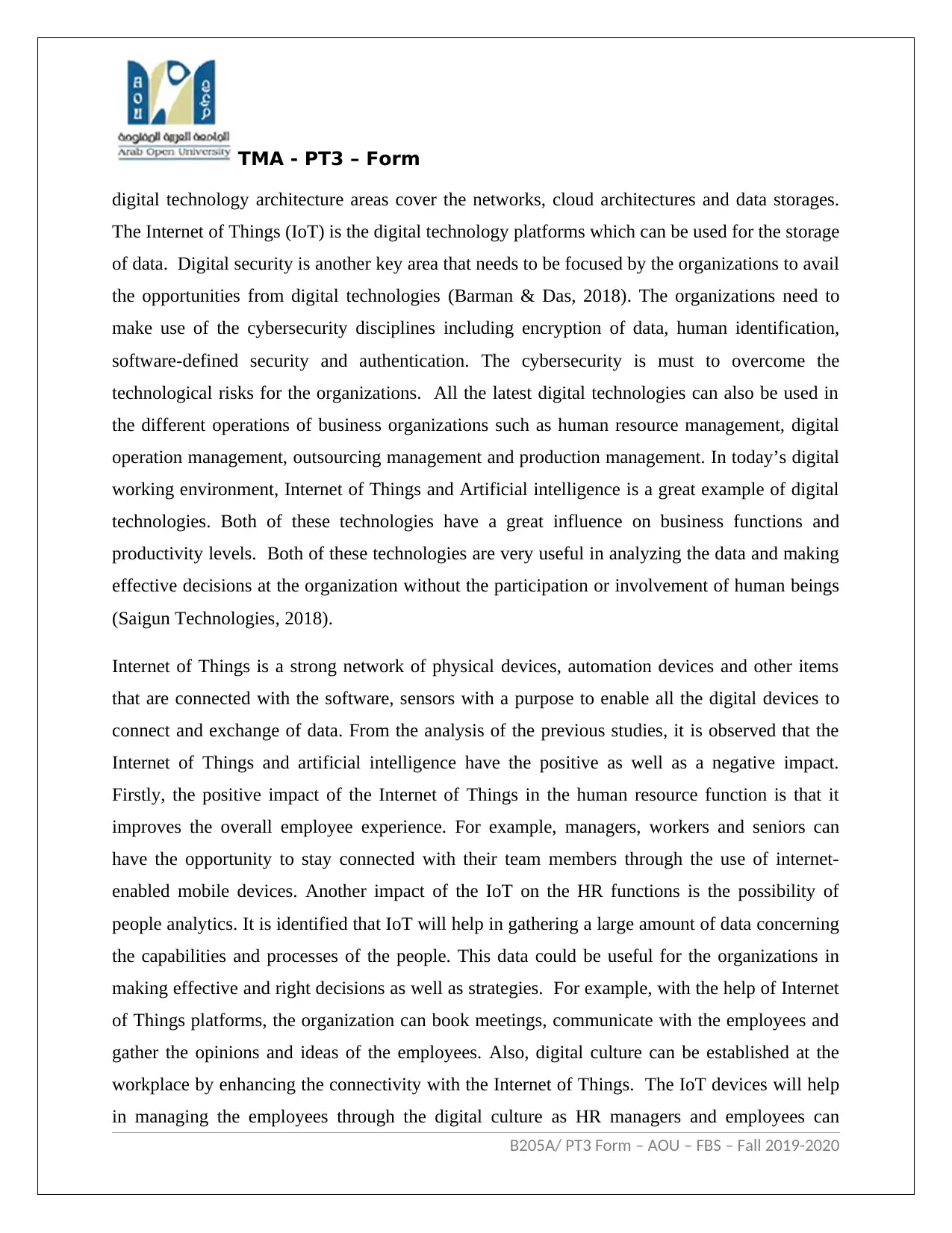
TMA - PT3 – Form
digital technology architecture areas cover the networks, cloud architectures and data storages.
The Internet of Things (IoT) is the digital technology platforms which can be used for the storage
of data. Digital security is another key area that needs to be focused by the organizations to avail
the opportunities from digital technologies (Barman & Das, 2018). The organizations need to
make use of the cybersecurity disciplines including encryption of data, human identification,
software-defined security and authentication. The cybersecurity is must to overcome the
technological risks for the organizations. All the latest digital technologies can also be used in
the different operations of business organizations such as human resource management, digital
operation management, outsourcing management and production management. In today’s digital
working environment, Internet of Things and Artificial intelligence is a great example of digital
technologies. Both of these technologies have a great influence on business functions and
productivity levels. Both of these technologies are very useful in analyzing the data and making
effective decisions at the organization without the participation or involvement of human beings
(Saigun Technologies, 2018).
Internet of Things is a strong network of physical devices, automation devices and other items
that are connected with the software, sensors with a purpose to enable all the digital devices to
connect and exchange of data. From the analysis of the previous studies, it is observed that the
Internet of Things and artificial intelligence have the positive as well as a negative impact.
Firstly, the positive impact of the Internet of Things in the human resource function is that it
improves the overall employee experience. For example, managers, workers and seniors can
have the opportunity to stay connected with their team members through the use of internet-
enabled mobile devices. Another impact of the IoT on the HR functions is the possibility of
people analytics. It is identified that IoT will help in gathering a large amount of data concerning
the capabilities and processes of the people. This data could be useful for the organizations in
making effective and right decisions as well as strategies. For example, with the help of Internet
of Things platforms, the organization can book meetings, communicate with the employees and
gather the opinions and ideas of the employees. Also, digital culture can be established at the
workplace by enhancing the connectivity with the Internet of Things. The IoT devices will help
in managing the employees through the digital culture as HR managers and employees can
B205A/ PT3 Form – AOU – FBS – Fall 2019-2020
digital technology architecture areas cover the networks, cloud architectures and data storages.
The Internet of Things (IoT) is the digital technology platforms which can be used for the storage
of data. Digital security is another key area that needs to be focused by the organizations to avail
the opportunities from digital technologies (Barman & Das, 2018). The organizations need to
make use of the cybersecurity disciplines including encryption of data, human identification,
software-defined security and authentication. The cybersecurity is must to overcome the
technological risks for the organizations. All the latest digital technologies can also be used in
the different operations of business organizations such as human resource management, digital
operation management, outsourcing management and production management. In today’s digital
working environment, Internet of Things and Artificial intelligence is a great example of digital
technologies. Both of these technologies have a great influence on business functions and
productivity levels. Both of these technologies are very useful in analyzing the data and making
effective decisions at the organization without the participation or involvement of human beings
(Saigun Technologies, 2018).
Internet of Things is a strong network of physical devices, automation devices and other items
that are connected with the software, sensors with a purpose to enable all the digital devices to
connect and exchange of data. From the analysis of the previous studies, it is observed that the
Internet of Things and artificial intelligence have the positive as well as a negative impact.
Firstly, the positive impact of the Internet of Things in the human resource function is that it
improves the overall employee experience. For example, managers, workers and seniors can
have the opportunity to stay connected with their team members through the use of internet-
enabled mobile devices. Another impact of the IoT on the HR functions is the possibility of
people analytics. It is identified that IoT will help in gathering a large amount of data concerning
the capabilities and processes of the people. This data could be useful for the organizations in
making effective and right decisions as well as strategies. For example, with the help of Internet
of Things platforms, the organization can book meetings, communicate with the employees and
gather the opinions and ideas of the employees. Also, digital culture can be established at the
workplace by enhancing the connectivity with the Internet of Things. The IoT devices will help
in managing the employees through the digital culture as HR managers and employees can
B205A/ PT3 Form – AOU – FBS – Fall 2019-2020
⊘ This is a preview!⊘
Do you want full access?
Subscribe today to unlock all pages.

Trusted by 1+ million students worldwide
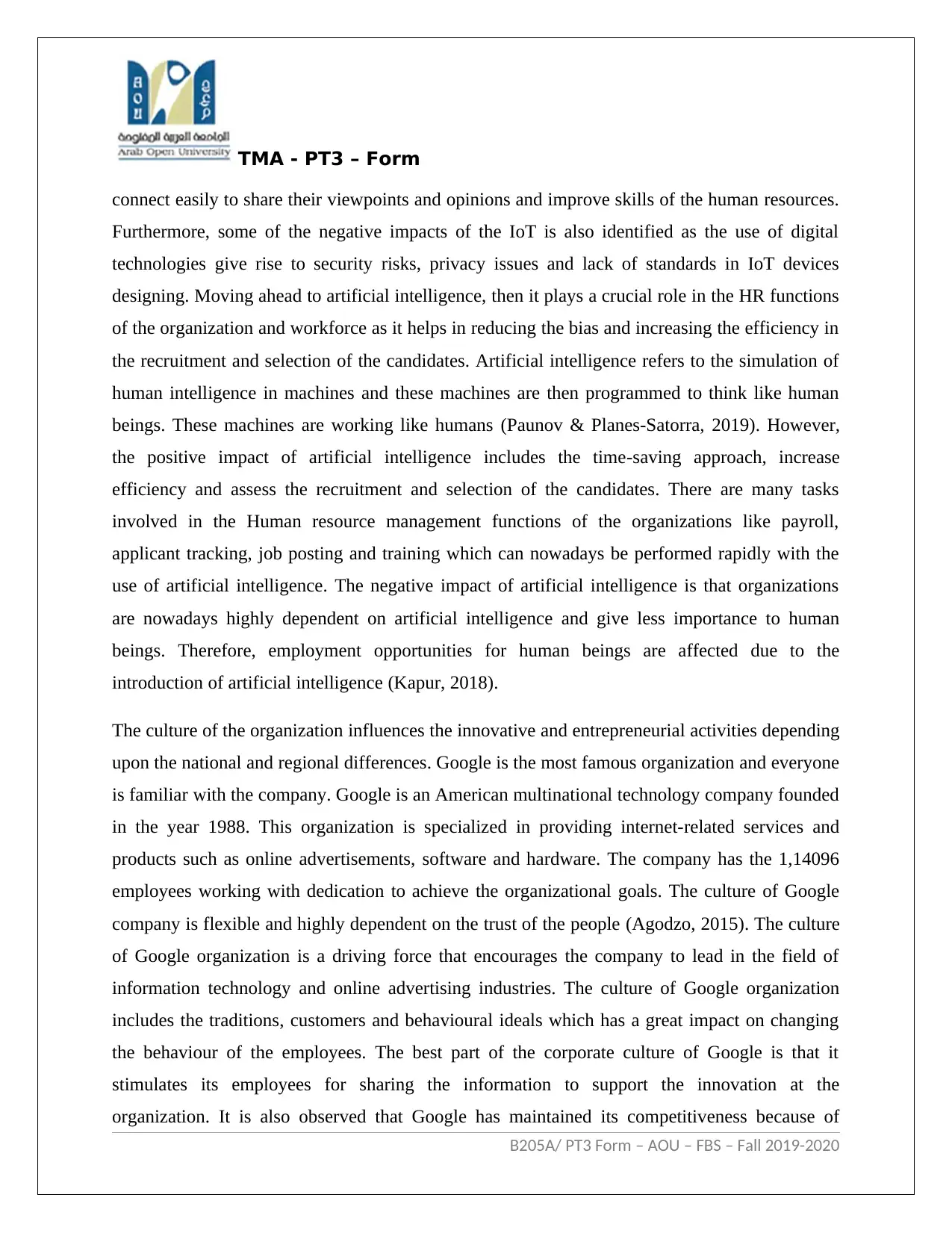
TMA - PT3 – Form
connect easily to share their viewpoints and opinions and improve skills of the human resources.
Furthermore, some of the negative impacts of the IoT is also identified as the use of digital
technologies give rise to security risks, privacy issues and lack of standards in IoT devices
designing. Moving ahead to artificial intelligence, then it plays a crucial role in the HR functions
of the organization and workforce as it helps in reducing the bias and increasing the efficiency in
the recruitment and selection of the candidates. Artificial intelligence refers to the simulation of
human intelligence in machines and these machines are then programmed to think like human
beings. These machines are working like humans (Paunov & Planes-Satorra, 2019). However,
the positive impact of artificial intelligence includes the time-saving approach, increase
efficiency and assess the recruitment and selection of the candidates. There are many tasks
involved in the Human resource management functions of the organizations like payroll,
applicant tracking, job posting and training which can nowadays be performed rapidly with the
use of artificial intelligence. The negative impact of artificial intelligence is that organizations
are nowadays highly dependent on artificial intelligence and give less importance to human
beings. Therefore, employment opportunities for human beings are affected due to the
introduction of artificial intelligence (Kapur, 2018).
The culture of the organization influences the innovative and entrepreneurial activities depending
upon the national and regional differences. Google is the most famous organization and everyone
is familiar with the company. Google is an American multinational technology company founded
in the year 1988. This organization is specialized in providing internet-related services and
products such as online advertisements, software and hardware. The company has the 1,14096
employees working with dedication to achieve the organizational goals. The culture of Google
company is flexible and highly dependent on the trust of the people (Agodzo, 2015). The culture
of Google organization is a driving force that encourages the company to lead in the field of
information technology and online advertising industries. The culture of Google organization
includes the traditions, customers and behavioural ideals which has a great impact on changing
the behaviour of the employees. The best part of the corporate culture of Google is that it
stimulates its employees for sharing the information to support the innovation at the
organization. It is also observed that Google has maintained its competitiveness because of
B205A/ PT3 Form – AOU – FBS – Fall 2019-2020
connect easily to share their viewpoints and opinions and improve skills of the human resources.
Furthermore, some of the negative impacts of the IoT is also identified as the use of digital
technologies give rise to security risks, privacy issues and lack of standards in IoT devices
designing. Moving ahead to artificial intelligence, then it plays a crucial role in the HR functions
of the organization and workforce as it helps in reducing the bias and increasing the efficiency in
the recruitment and selection of the candidates. Artificial intelligence refers to the simulation of
human intelligence in machines and these machines are then programmed to think like human
beings. These machines are working like humans (Paunov & Planes-Satorra, 2019). However,
the positive impact of artificial intelligence includes the time-saving approach, increase
efficiency and assess the recruitment and selection of the candidates. There are many tasks
involved in the Human resource management functions of the organizations like payroll,
applicant tracking, job posting and training which can nowadays be performed rapidly with the
use of artificial intelligence. The negative impact of artificial intelligence is that organizations
are nowadays highly dependent on artificial intelligence and give less importance to human
beings. Therefore, employment opportunities for human beings are affected due to the
introduction of artificial intelligence (Kapur, 2018).
The culture of the organization influences the innovative and entrepreneurial activities depending
upon the national and regional differences. Google is the most famous organization and everyone
is familiar with the company. Google is an American multinational technology company founded
in the year 1988. This organization is specialized in providing internet-related services and
products such as online advertisements, software and hardware. The company has the 1,14096
employees working with dedication to achieve the organizational goals. The culture of Google
company is flexible and highly dependent on the trust of the people (Agodzo, 2015). The culture
of Google organization is a driving force that encourages the company to lead in the field of
information technology and online advertising industries. The culture of Google organization
includes the traditions, customers and behavioural ideals which has a great impact on changing
the behaviour of the employees. The best part of the corporate culture of Google is that it
stimulates its employees for sharing the information to support the innovation at the
organization. It is also observed that Google has maintained its competitiveness because of
B205A/ PT3 Form – AOU – FBS – Fall 2019-2020
Paraphrase This Document
Need a fresh take? Get an instant paraphrase of this document with our AI Paraphraser
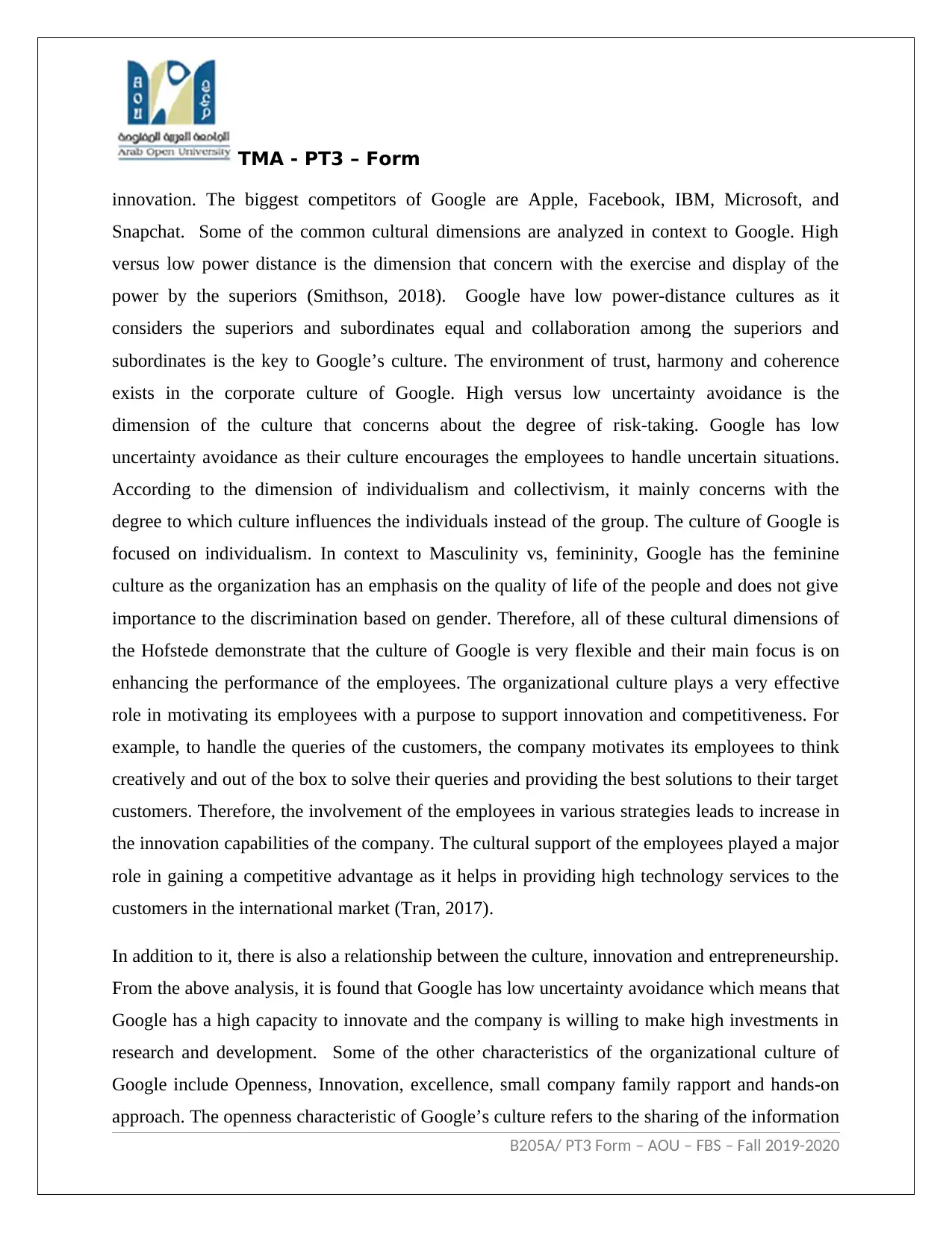
TMA - PT3 – Form
innovation. The biggest competitors of Google are Apple, Facebook, IBM, Microsoft, and
Snapchat. Some of the common cultural dimensions are analyzed in context to Google. High
versus low power distance is the dimension that concern with the exercise and display of the
power by the superiors (Smithson, 2018). Google have low power-distance cultures as it
considers the superiors and subordinates equal and collaboration among the superiors and
subordinates is the key to Google’s culture. The environment of trust, harmony and coherence
exists in the corporate culture of Google. High versus low uncertainty avoidance is the
dimension of the culture that concerns about the degree of risk-taking. Google has low
uncertainty avoidance as their culture encourages the employees to handle uncertain situations.
According to the dimension of individualism and collectivism, it mainly concerns with the
degree to which culture influences the individuals instead of the group. The culture of Google is
focused on individualism. In context to Masculinity vs, femininity, Google has the feminine
culture as the organization has an emphasis on the quality of life of the people and does not give
importance to the discrimination based on gender. Therefore, all of these cultural dimensions of
the Hofstede demonstrate that the culture of Google is very flexible and their main focus is on
enhancing the performance of the employees. The organizational culture plays a very effective
role in motivating its employees with a purpose to support innovation and competitiveness. For
example, to handle the queries of the customers, the company motivates its employees to think
creatively and out of the box to solve their queries and providing the best solutions to their target
customers. Therefore, the involvement of the employees in various strategies leads to increase in
the innovation capabilities of the company. The cultural support of the employees played a major
role in gaining a competitive advantage as it helps in providing high technology services to the
customers in the international market (Tran, 2017).
In addition to it, there is also a relationship between the culture, innovation and entrepreneurship.
From the above analysis, it is found that Google has low uncertainty avoidance which means that
Google has a high capacity to innovate and the company is willing to make high investments in
research and development. Some of the other characteristics of the organizational culture of
Google include Openness, Innovation, excellence, small company family rapport and hands-on
approach. The openness characteristic of Google’s culture refers to the sharing of the information
B205A/ PT3 Form – AOU – FBS – Fall 2019-2020
innovation. The biggest competitors of Google are Apple, Facebook, IBM, Microsoft, and
Snapchat. Some of the common cultural dimensions are analyzed in context to Google. High
versus low power distance is the dimension that concern with the exercise and display of the
power by the superiors (Smithson, 2018). Google have low power-distance cultures as it
considers the superiors and subordinates equal and collaboration among the superiors and
subordinates is the key to Google’s culture. The environment of trust, harmony and coherence
exists in the corporate culture of Google. High versus low uncertainty avoidance is the
dimension of the culture that concerns about the degree of risk-taking. Google has low
uncertainty avoidance as their culture encourages the employees to handle uncertain situations.
According to the dimension of individualism and collectivism, it mainly concerns with the
degree to which culture influences the individuals instead of the group. The culture of Google is
focused on individualism. In context to Masculinity vs, femininity, Google has the feminine
culture as the organization has an emphasis on the quality of life of the people and does not give
importance to the discrimination based on gender. Therefore, all of these cultural dimensions of
the Hofstede demonstrate that the culture of Google is very flexible and their main focus is on
enhancing the performance of the employees. The organizational culture plays a very effective
role in motivating its employees with a purpose to support innovation and competitiveness. For
example, to handle the queries of the customers, the company motivates its employees to think
creatively and out of the box to solve their queries and providing the best solutions to their target
customers. Therefore, the involvement of the employees in various strategies leads to increase in
the innovation capabilities of the company. The cultural support of the employees played a major
role in gaining a competitive advantage as it helps in providing high technology services to the
customers in the international market (Tran, 2017).
In addition to it, there is also a relationship between the culture, innovation and entrepreneurship.
From the above analysis, it is found that Google has low uncertainty avoidance which means that
Google has a high capacity to innovate and the company is willing to make high investments in
research and development. Some of the other characteristics of the organizational culture of
Google include Openness, Innovation, excellence, small company family rapport and hands-on
approach. The openness characteristic of Google’s culture refers to the sharing of the information
B205A/ PT3 Form – AOU – FBS – Fall 2019-2020
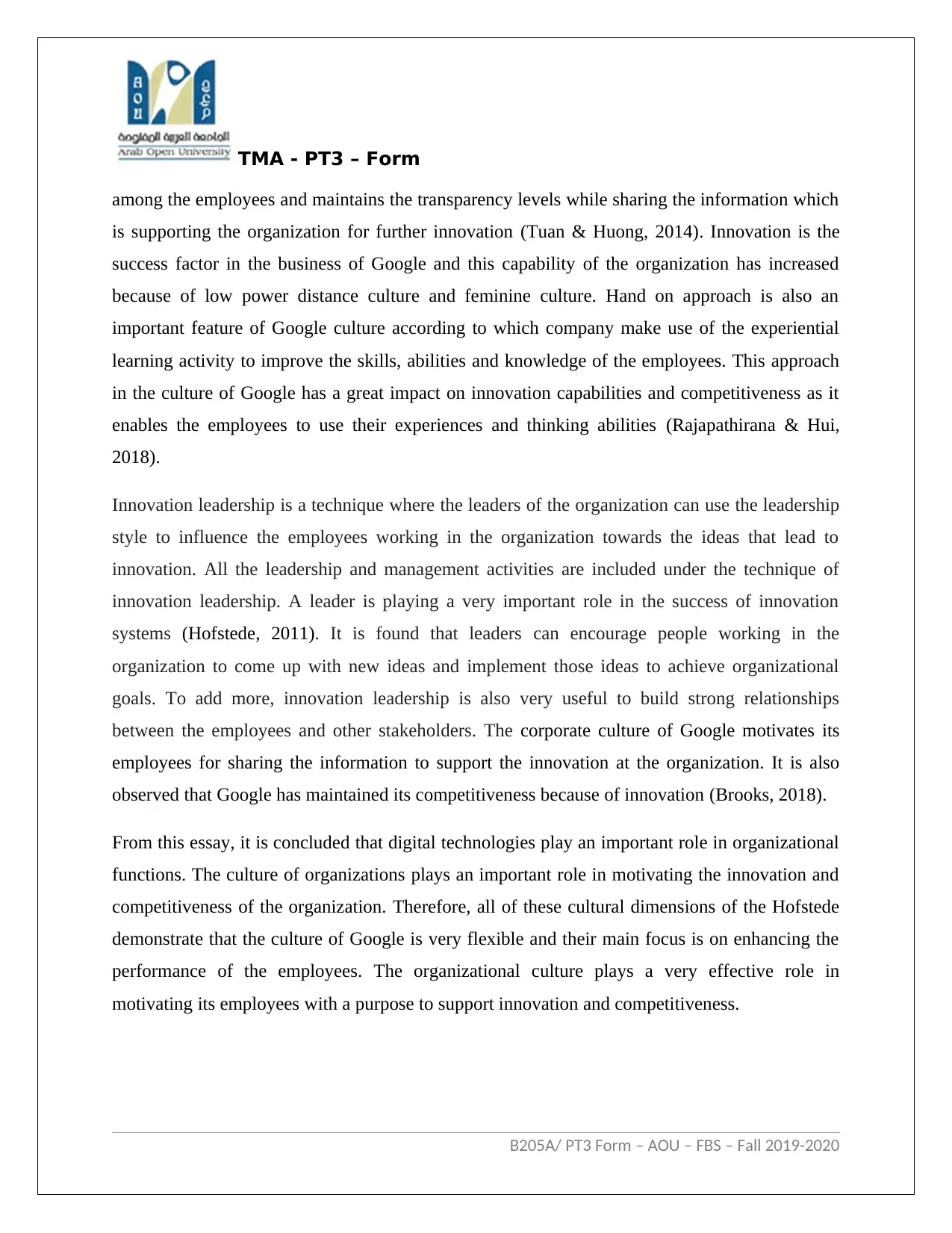
TMA - PT3 – Form
among the employees and maintains the transparency levels while sharing the information which
is supporting the organization for further innovation (Tuan & Huong, 2014). Innovation is the
success factor in the business of Google and this capability of the organization has increased
because of low power distance culture and feminine culture. Hand on approach is also an
important feature of Google culture according to which company make use of the experiential
learning activity to improve the skills, abilities and knowledge of the employees. This approach
in the culture of Google has a great impact on innovation capabilities and competitiveness as it
enables the employees to use their experiences and thinking abilities (Rajapathirana & Hui,
2018).
Innovation leadership is a technique where the leaders of the organization can use the leadership
style to influence the employees working in the organization towards the ideas that lead to
innovation. All the leadership and management activities are included under the technique of
innovation leadership. A leader is playing a very important role in the success of innovation
systems (Hofstede, 2011). It is found that leaders can encourage people working in the
organization to come up with new ideas and implement those ideas to achieve organizational
goals. To add more, innovation leadership is also very useful to build strong relationships
between the employees and other stakeholders. The corporate culture of Google motivates its
employees for sharing the information to support the innovation at the organization. It is also
observed that Google has maintained its competitiveness because of innovation (Brooks, 2018).
From this essay, it is concluded that digital technologies play an important role in organizational
functions. The culture of organizations plays an important role in motivating the innovation and
competitiveness of the organization. Therefore, all of these cultural dimensions of the Hofstede
demonstrate that the culture of Google is very flexible and their main focus is on enhancing the
performance of the employees. The organizational culture plays a very effective role in
motivating its employees with a purpose to support innovation and competitiveness.
B205A/ PT3 Form – AOU – FBS – Fall 2019-2020
among the employees and maintains the transparency levels while sharing the information which
is supporting the organization for further innovation (Tuan & Huong, 2014). Innovation is the
success factor in the business of Google and this capability of the organization has increased
because of low power distance culture and feminine culture. Hand on approach is also an
important feature of Google culture according to which company make use of the experiential
learning activity to improve the skills, abilities and knowledge of the employees. This approach
in the culture of Google has a great impact on innovation capabilities and competitiveness as it
enables the employees to use their experiences and thinking abilities (Rajapathirana & Hui,
2018).
Innovation leadership is a technique where the leaders of the organization can use the leadership
style to influence the employees working in the organization towards the ideas that lead to
innovation. All the leadership and management activities are included under the technique of
innovation leadership. A leader is playing a very important role in the success of innovation
systems (Hofstede, 2011). It is found that leaders can encourage people working in the
organization to come up with new ideas and implement those ideas to achieve organizational
goals. To add more, innovation leadership is also very useful to build strong relationships
between the employees and other stakeholders. The corporate culture of Google motivates its
employees for sharing the information to support the innovation at the organization. It is also
observed that Google has maintained its competitiveness because of innovation (Brooks, 2018).
From this essay, it is concluded that digital technologies play an important role in organizational
functions. The culture of organizations plays an important role in motivating the innovation and
competitiveness of the organization. Therefore, all of these cultural dimensions of the Hofstede
demonstrate that the culture of Google is very flexible and their main focus is on enhancing the
performance of the employees. The organizational culture plays a very effective role in
motivating its employees with a purpose to support innovation and competitiveness.
B205A/ PT3 Form – AOU – FBS – Fall 2019-2020
⊘ This is a preview!⊘
Do you want full access?
Subscribe today to unlock all pages.

Trusted by 1+ million students worldwide
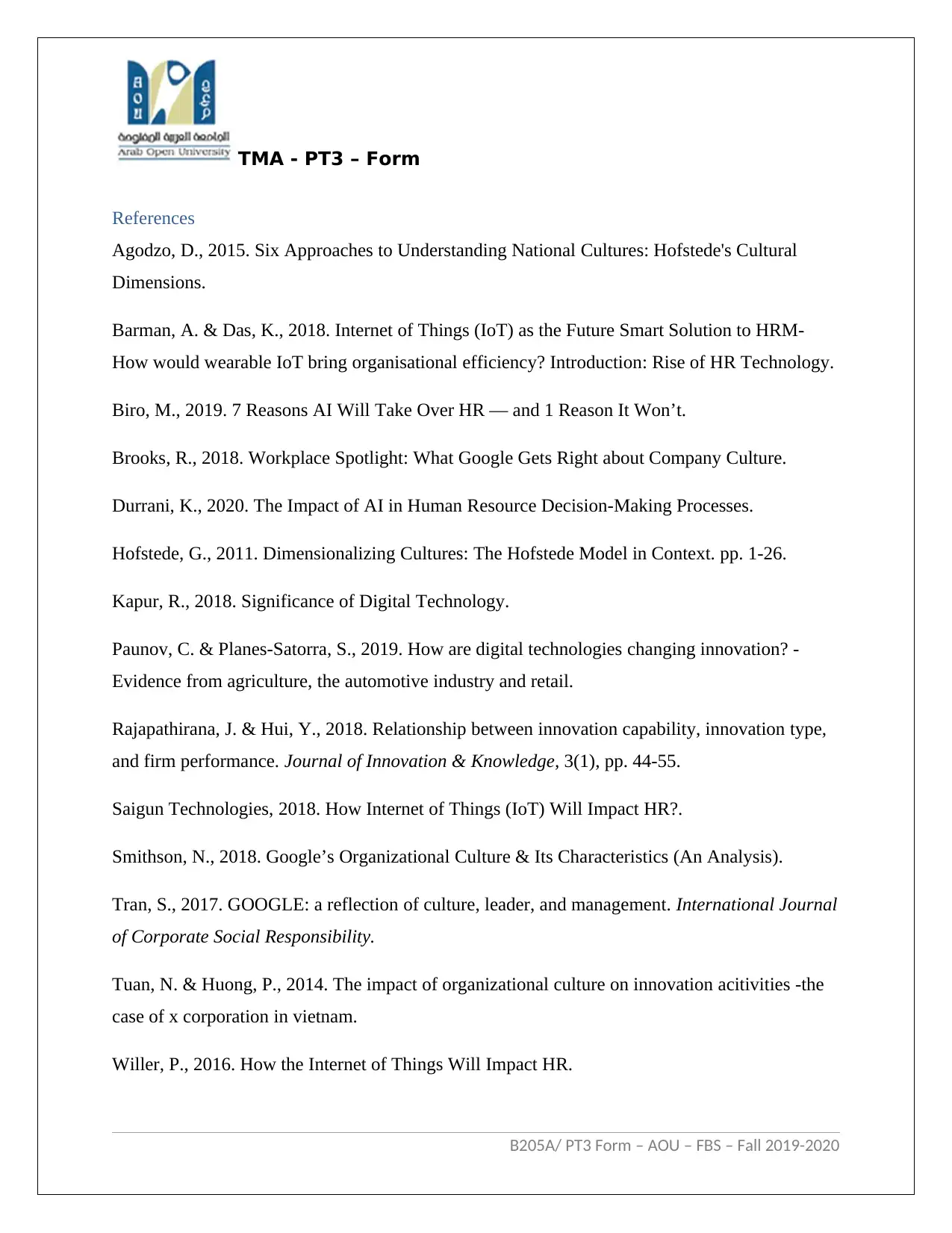
TMA - PT3 – Form
References
Agodzo, D., 2015. Six Approaches to Understanding National Cultures: Hofstede's Cultural
Dimensions.
Barman, A. & Das, K., 2018. Internet of Things (IoT) as the Future Smart Solution to HRM-
How would wearable IoT bring organisational efficiency? Introduction: Rise of HR Technology.
Biro, M., 2019. 7 Reasons AI Will Take Over HR — and 1 Reason It Won’t.
Brooks, R., 2018. Workplace Spotlight: What Google Gets Right about Company Culture.
Durrani, K., 2020. The Impact of AI in Human Resource Decision-Making Processes.
Hofstede, G., 2011. Dimensionalizing Cultures: The Hofstede Model in Context. pp. 1-26.
Kapur, R., 2018. Significance of Digital Technology.
Paunov, C. & Planes-Satorra, S., 2019. How are digital technologies changing innovation? -
Evidence from agriculture, the automotive industry and retail.
Rajapathirana, J. & Hui, Y., 2018. Relationship between innovation capability, innovation type,
and firm performance. Journal of Innovation & Knowledge, 3(1), pp. 44-55.
Saigun Technologies, 2018. How Internet of Things (IoT) Will Impact HR?.
Smithson, N., 2018. Google’s Organizational Culture & Its Characteristics (An Analysis).
Tran, S., 2017. GOOGLE: a reflection of culture, leader, and management. International Journal
of Corporate Social Responsibility.
Tuan, N. & Huong, P., 2014. The impact of organizational culture on innovation acitivities -the
case of x corporation in vietnam.
Willer, P., 2016. How the Internet of Things Will Impact HR.
B205A/ PT3 Form – AOU – FBS – Fall 2019-2020
References
Agodzo, D., 2015. Six Approaches to Understanding National Cultures: Hofstede's Cultural
Dimensions.
Barman, A. & Das, K., 2018. Internet of Things (IoT) as the Future Smart Solution to HRM-
How would wearable IoT bring organisational efficiency? Introduction: Rise of HR Technology.
Biro, M., 2019. 7 Reasons AI Will Take Over HR — and 1 Reason It Won’t.
Brooks, R., 2018. Workplace Spotlight: What Google Gets Right about Company Culture.
Durrani, K., 2020. The Impact of AI in Human Resource Decision-Making Processes.
Hofstede, G., 2011. Dimensionalizing Cultures: The Hofstede Model in Context. pp. 1-26.
Kapur, R., 2018. Significance of Digital Technology.
Paunov, C. & Planes-Satorra, S., 2019. How are digital technologies changing innovation? -
Evidence from agriculture, the automotive industry and retail.
Rajapathirana, J. & Hui, Y., 2018. Relationship between innovation capability, innovation type,
and firm performance. Journal of Innovation & Knowledge, 3(1), pp. 44-55.
Saigun Technologies, 2018. How Internet of Things (IoT) Will Impact HR?.
Smithson, N., 2018. Google’s Organizational Culture & Its Characteristics (An Analysis).
Tran, S., 2017. GOOGLE: a reflection of culture, leader, and management. International Journal
of Corporate Social Responsibility.
Tuan, N. & Huong, P., 2014. The impact of organizational culture on innovation acitivities -the
case of x corporation in vietnam.
Willer, P., 2016. How the Internet of Things Will Impact HR.
B205A/ PT3 Form – AOU – FBS – Fall 2019-2020
Paraphrase This Document
Need a fresh take? Get an instant paraphrase of this document with our AI Paraphraser
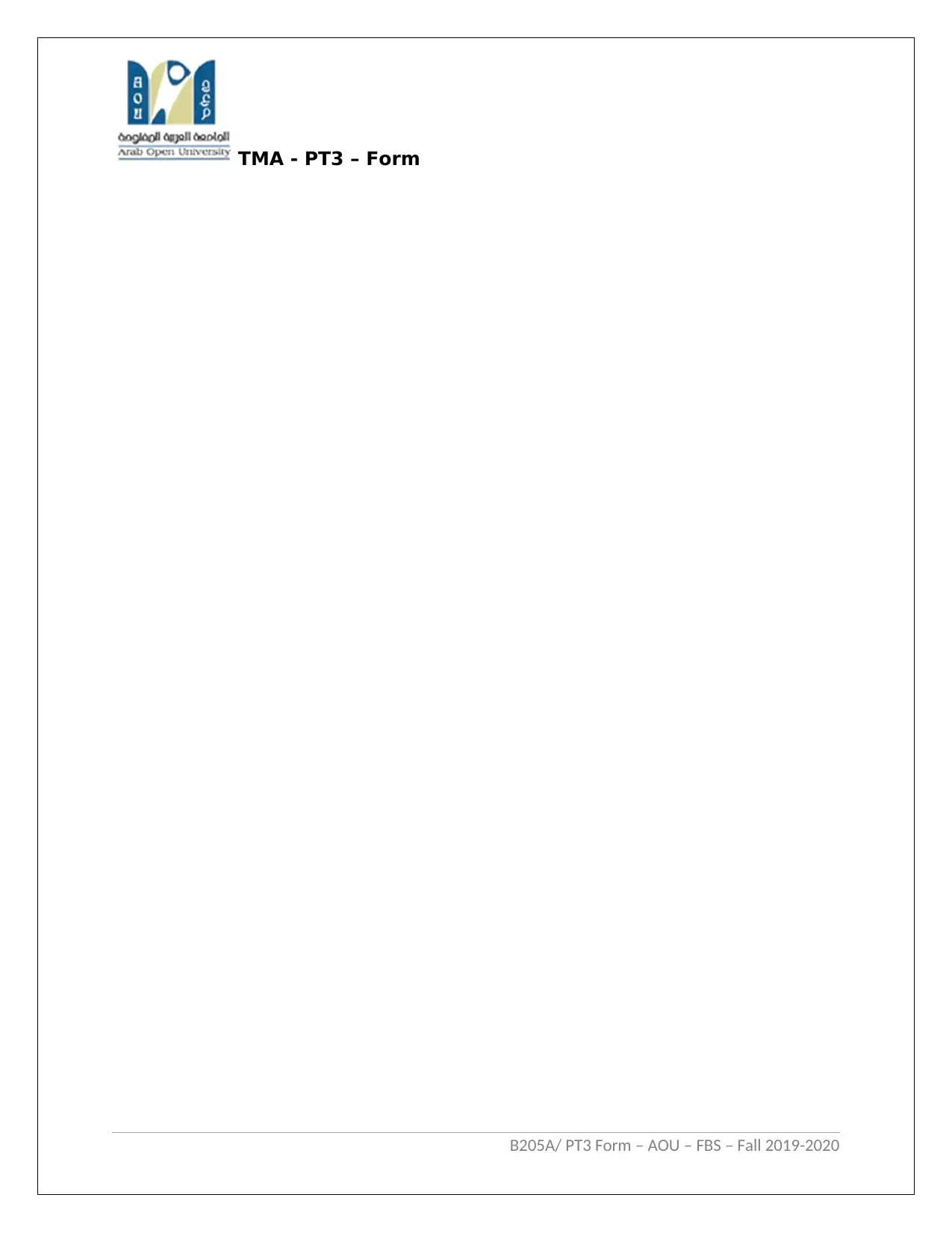
TMA - PT3 – Form
B205A/ PT3 Form – AOU – FBS – Fall 2019-2020
B205A/ PT3 Form – AOU – FBS – Fall 2019-2020
1 out of 8
Related Documents
Your All-in-One AI-Powered Toolkit for Academic Success.
+13062052269
info@desklib.com
Available 24*7 on WhatsApp / Email
![[object Object]](/_next/static/media/star-bottom.7253800d.svg)
Unlock your academic potential
Copyright © 2020–2025 A2Z Services. All Rights Reserved. Developed and managed by ZUCOL.





